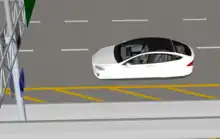
A hover car is a personal vehicle that flies at a constant altitude of up to a few meters (yards) above the ground and used for personal transportation in the same way a modern automobile is employed. The concept usually appears in science fiction.
In science fiction, it is capable of elevating itself some distance from the ground through some repulsion technology, presumably exploiting some short range anti-gravity principle so as to eliminate most friction forces which act against conventional vehicles. Other works feature vehicles that hover by having magnetic plates lined along roads, operating in a similar principle to Maglev. The capability of hovering above the ground eliminates the need for tires, and unlike an air-cushion vehicle, it does not produce a dust cloud.
The closest devices are the hovercraft, which elevates itself above a water or level hard surface using a cushion of air retained by a flexible skirt, and the hovertrain, which is a type of high-speed train that replaces conventional steel wheels with hovercraft lift pads, and the conventional railway bed with a paved road-like surface, known as the "track" or "guideway".
Efforts to build air-cushion hover cars
Air-cushion hover cars are hovercraft.
In April 1958, Ford engineers demonstrated the Glide-air, a one-metre (three-foot) model of a wheelless vehicle that speeds on a thin film of air only 76.2 μm (3⁄1000 of an inch) above its table top roadbed. An article in Modern Mechanix quoted Andrew A. Kucher, Ford's vice president in charge of Engineering and Research noting "We look upon Glide-air as a new form of high-speed land transportation, probably in the field of rail surface travel, for fast trips of distances of up to about 1,600 kilometres (1,000 mi)".[6]
In 1959, Ford displayed a hovercraft concept car, the Ford Levacar Mach I.[7]
In August 1961, Popular Science reported on the Aeromobile 35B, an air-cushion vehicle (ACV) that was invented by William Bertelsen and was envisioned to revolutionise the transportation system, with personal hovering self-driving cars that could speed up to 2,400 km/h (1,500 mph).
Efforts to build MagLev hover cars
Ford also displayed a concept car, LEVICAR. It was a one-person, small in a modern sense, car propelled by maglev. The car was designed to be levitated by magnets, and was intended to be developed for high-speed transportation systems. The Levicar was very light and when raised off its guide rail by the magnetic it only required a blower in the back to propel it. A working model was actually built. While technically a success, the whole project was dropped due to financial constraints.[8]
In popular culture
In science fiction films and television
- Supercar (TV series)
- The Jetsons
- Futurama
- Rise and Fall of the Trigan Empire
- Blade Runner saga (as Spinner)
- A.I.
- Minority Report
- I, Robot
- Star Trek saga (skimmers and desert fliers; the latter being a Vulcan hovercar)
- Star Wars saga (as grav-cars, airflow cars, hover cars, trundle cars, hauler cars and landspeeders)
- Total Recall
- Agents of S.H.I.E.L.D.
- Back to the Future Part II
- Lilo & Stitch
- The Fifth Element
- The Adventures of Jimmy Neutron: Boy Genius
- Altered Carbon
- Stand by Me Doraemon
- Space Precinct (as hoppers)
- Tomorrowland
- Immortal (2004 film) (unique type of hovercar, which is powered by overhead wires)
- Robot Jox
In video games
- TimeSplitters
- F-Zero
- Rock n' Roll Racing
- Quarantine (1994 video game)|Quarantine
- Quarantine II: Road Warrior (1995 video game)
- Wipeout
- Space Quest I
- Beam Breakers
- Fallout
- Redout
- Jak 2
- Saints Row 4
- Overwatch
- Does not Commute
- Grand Theft Auto Online
- BHunter[9]
- Aircar (video game)|Aircar[10]
- Hover!
- Hover Ace[11][12]
- ReVOLUTION[13]
- Nikopol: Secrets of the Immortals
- Cloudpunk (as HOVA)
- Blade Runner (as Spinner)
- NYR: New York Race (contains hovercars from The Fifth Element)
See also
References
- ↑ Brophy, Jim (4 September 2021). "1959 Curtiss-Wright Air Car 2500 – Like Riding on a Cloud…". Curbside Classic. Retrieved 4 May 2022.
- ↑ Wojdyla, Ben (2 February 2015). "Luke Skywalker, your landspeeder is ready". Road & Track. Retrieved 4 May 2022.
- ↑ "1959 Curtiss-Wright Model 2500 Air-Car". ThrottleXtreme. 18 October 2017. Retrieved 4 May 2022.
- ↑ "This Unbelievable 1959 Curtiss-Wright Model 2500 Air-Car". Design You Trust. Retrieved 4 May 2022.
- ↑ "April Artifact of the Month: Curtiss-Wright Model 2500 Air Car". U.S. Army Transportation Museum. March 23, 2021. Retrieved 4 May 2022.
- ↑ "Cars That Fly" Archived 2011-06-12 at the Wayback Machine, Modern Mechanix, October 1958, pp. 92–95
- ↑
- Ford, Jason (18 June 2019). "June 1960: Floating a new idea". The Engineer. Archived from the original on June 18, 2019. Retrieved 11 May 2020 – via theengineer.co.uk.
- "Locomotion" (PDF). The Engineer. June 3, 1960. p. 930. Archived from the original (PDF) on 2022-05-03. Retrieved 4 May 2022 – via theengineer.co.uk.
- ↑ "Ford Scientific Research Laboratory Reaches 50 Year Milestone". Ford Motor Company. Archived from the original on 2013-07-21. Retrieved 2013-09-13.
For example, LEVICAR, a vehicle levitated by magnets, was developed for high-speed transportation systems. The LEVICAR only required a blower in the back to propel it, and a working model was actually built. Although the LEVICAR program was dropped for economic reasons, it was technically successful.
- ↑ The Collection Chamber, game collector's blog
- ↑ Aircar on steam
- ↑ MobyGames page, video game database
- ↑ Official website, unmaintained
- ↑ MobyGames page, video game database
